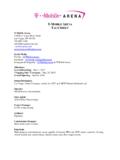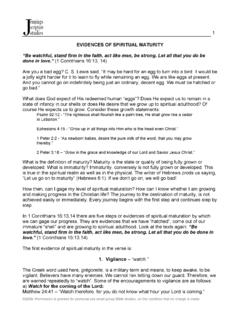Transcription of Basic Ice Rink Building Design Scope - Arena Watch
1 1 Basic Ice rink Building Design Scope OVERVIEW: In order to create the most energy efficient Building possible, and based upon cost-effective amortization schedules, JBURLEY has produced this quick overview of minimum Design criteria for the Building . The investment toward this Design approach has shown to quickly return the added construction cost with the total complex s energy performance or has been found to be mandatory for the environmental demands of a skating complex. A more extensive Building Design Scope is available through JBURLEY upon request. Building INSULATION: Main Arena walls should be insulated to a minimum of an R-19 in the sidewalls, and R-30 in the roof. Fiberglass insulation has proven to be the most cost effective material to use for this application. Rinks that will only operate on a seasonal basis can use an R-19 in the ceiling and in the sidewalls. We recommend against designing your complex as a seasonal complex because of the significantly inflated expense of adding insulation to a structure at a later date.
2 An ice rink is NOT like a conventional Building . It MUST have a vapor barrier installed in a totally different manner than any other Building application. Following these proper vapor barrier Design methods is mandatory to avoid insulation failure from condensation formation within the insulation membrane. In an ice rink Building , vapor barriers must be placed on the outside of the insulation membrane, as opposed to the inside, which is standard with conventional construction. This vapor barrier must be a true vapor barrier such as a polyethylene, polypropylene, or similar type material with a low perm rating. Kraft paper is not considered an acceptable vapor barrier for an ice rink application. Before the outside metal panels are installed, this vapor barrier must be placed on both the roof and sidewalls. Radiant heat transmitted from the Arena ceiling into the ice sheet is a major ice floor load that can be virtually eliminated with proper Building Design .
3 The ceiling must be a 2 material type which produces a Low "E" value (Emissivity). Selecting the proper material for the ceiling over the ice sheet has proven to reduce the overall ice sheet loads by 30% or more. The inside surface of the ceiling facing the ice sheet must be a low "E" (Emissivity) material such as polished aluminum. When standing on the ice sheet looking up, you will see the polished aluminum surface exposed. Polyester foil films are not acceptable as a Low "E" material despite their like appearance. The Low "E" scrim must be perforated to permit the insulation membrane to "breathe" should flaws occur with the external vapor barrier during construction. The sidewalls are not quite as critical regarding "E" value. They preferably should be a Low "E" material, however, a white vinyl facing will not significantly effect the ice sheet load. Moisture vapor control in an ice rink is the most commonly made Design error, and also the most important aspect of the overall insulation system.
4 Vapor barriers are also required below all rink slabs poured on grade within the rink proper, and on all internal walls. For the internal walls, the vapor barrier is to be placed on the warm side of the wall that is the side away from the rink area. The rink area must be considered the coldest room where moisture flow will be drawn. CONCRETE SLABS ON GRADE: All concrete slabs are to be finished in a manner for easy installation of rubber flooring. The finishing specification for the slabs should be similar to ceramic tile for texture, levelness, and ability to take an adhesive application. All slabs must have a vapor barrier placed below them when they are located within the rink area. Concrete is NOT to be provided within the rink surface area as this portion of the complex is the rink contractor's responsibility. These areas are to be left in a rough grade condition per JBURLEY plans and specifications. The edge of the rink floor shall feature a "honch", which extends downward 16" from the finished floor elevation and is 12" wide.
5 The concrete used for the honch area and adjoining concrete must be a minimum of 4000 psi at 28 days. The rink perimeter and honch location will support the mounting of the rink dasher board system. Finished elevation of this area is critical and must be place at a tolerance of (+ or -) 1/8" in 10', or 3/8" over the entire rink perimeter. Any slopes required outside the rink for ramps, drains, or similar purpose must not begin any closer than 24" from the rink edge. Some areas of the rink perimeter may require forming for installation of the rink floor transmission piping. See JBURLEY plans and specifications for coordination. 3 INTERIOR FIT-OUT: Metal liner panels, or similar materials, should be installed to a minimum of 8' high on all internal walls to prevent damage of sidewall insulation. All locker rooms and restrooms should be constructed from masonry block with an epoxy-type paint applied as a finish. These areas must withstand a high degree of abuse from hockey players and the public.
6 Drywall will prove to be extremely maintenance orientated and is to be avoided. Any suspended or drop ceiling used in the rink must be MOISTURE PROOF & RUST PROOF. Drop ceilings, or "T" bar type suspended ceilings within the rink environment are NOT recommended. All materials used in the construction and finishes in the main area should be designed for a high moisture application. Heated rooms or areas separate from the rink area, must provide for special wall construction as not to create a condensation condition within the wall membrane. Partition walls between the rink area and other internal rink areas must be constructed similar to an exterior wall with special provisions to properly placed vapor barriers. Follow the above noted requirements for vapor barrier application. LIGHTING SYSTEMS The main Arena lighting should be a 400 watt metal halide type fixtures, type fixtures providing the minimum candlepower levels: Level 1 100 to 120 Level 2 50 to 75 Level 3 25 The operator must be permitted to adjust their complexes lighting level based upon the planned activity.
7 Only rinks with tournament hockey play, or professional hockey complexes require Level 1 lighting levels. Standard Arena complexes can operate with a maximum of Level 2 lighting levels. The fixture must be installed for even lighting patterns. All of the lighting fixtures are to be suspended at the same elevation across the entire rink floor. Care should be made to coordinate the light fixture placement with the dehumidifier discharge air. 4 ELECTRICAL REQUIREMENTS Main power service shall be sized by the electrical engineer. The power requirements in an ice rink include, but may not be limited to the following: Main chiller system Supplemental heater system for sub-floor heating system Dehumidifiers Main area lights Room lighting Concession equipment Building alarm system Water heaters Sound system Proshop service Skate sharpening machine Scoreboard Outer Core Room air-conditioning Any electrical heat employed in Building Design External lighting Standard 110 volt outlets Game room service Emergency lighting system Service if electrical Zamboni is used Etc.
8 Refer to JBURLEY plans and specifications for the exact electrical requirements of the ice making and dehumidification system. If at all possible, natural gas is recommended over electric for any heating required of the complex. PLUMBING: A 1-1/2" main hot and cold water service should be supplied in the resurfacer room for ice making and resurfacer filling. This service must be equipped with a hose connection and thermometer to permit easy operator adjustment of the resurfacing water temperatures. The service must be capable of producing a minimum of 180 gallons of 130 degree F water per hour for a 5 full size ice sheet. For two (2) full size rinks, simply double the above requirements. For a full size rink and a 120 x 60 studio rink , the minimum should be 270 gallons of hot water per hour. Hot and cold water supply should be supplied from a single plumbing outlet, permitting the operator easy control of the water temperature with manual mixing valve arrangement and thermometer.
9 A 1-1/2" cold water service must be available for floor charging and for the ice Building process. Floor drains should be supplied where the resurfacer enters the ice sheet and in the mechanical room. If a snow pit is included in the Design , it shall be equipped with a removable 4" dia schedule 40 stand pipe, 18" high. See JBURLEY typical Design drawings for more details. DEHUMIDIFIERS: The mechanical contractor shall install the self-contained Arid-Aire dehumidifiers supplied by JBURLEY. The contractor will be responsible to furnish and supply any required ductwork for new air ventilation requirements, a drain from each unit to waste, a 30 amp 460/3/60 volt service for each unit, and unit mounting. The dehumidifiers can be equipped with manual damper controls, or automatic damper controls with a manual override to discontinue new air ventilation when the complex is not being utilized. Two (2) such units are required for each full size rink .
10 If a studio rink is installed, but will not operate in the summer, a dehumidifier would not be required for the studio surface. If the studio rink operates in the summer one (1) dehumidifier would be required. The fresh air percentage will be determined by local code requirements for new air ventilation. For More Information Contact.





